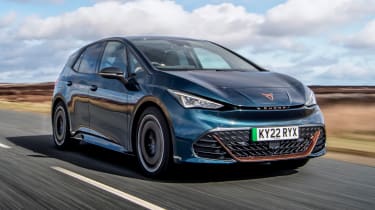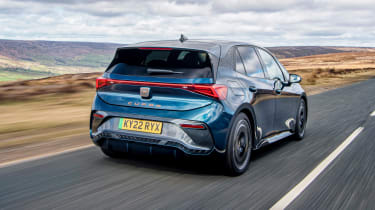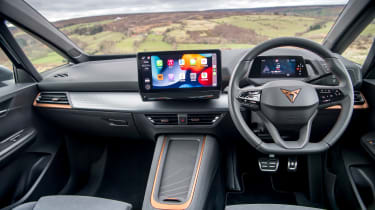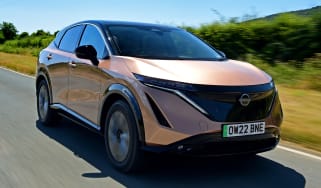New Cupra Born 2022 review
The Cupra Born promises a sportier flavour over its Volkswagen ID.3 sibling, so does it deliver the thrills?
When we first drove the Born we felt the pick of the bunch might be the more powerful version, and having driven the middle battery offering here, our opinion hasn’t changed. Cupra has done well in making the Born feel sportier than its VW ID.3 cousin, especially given the limitations of electric powertrains, but we’d be happy to trade some more practicality for additional performance to truly set the Born apart.
The first all-electric car from Cupra, the new Born hatchback has plenty riding on it. It’s the second car to come from SEAT’s sporty sub-brand, following the Cupra Formentor SUV. With the might of the Volkswagen Group behind it, the Born should have all the tools to make a big impact on the rapidly growing family EV segment.
It feels like we’ve been waiting for the Born for a while, given the 2019 el-Born concept was virtually identical in design to this production car. The Born’s sister car, the Volkswagen ID.3, was launched in 2020 and the electric car market moves quickly, so Cupra will be hoping its new EV still looks and feels fresh in 2022 and beyond.
There’ll be three powertrains available for the Born; an entry-level 45kWh will be on sale later this year, as will a 77kWh version. Splitting them is the 58kWh battery model that’s on sale now.
More reviews
Car group tests
- Renault Megane E-Tech vs Cupra Born: 2022 twin test review
- Cupra Born vs Mercedes EQA vs Volvo C40 Recharge: 2021 group test review
In-depth reviews
Long-term tests
Road tests
The Born gets three trim levels, starting with V1, then V2 and the range-topping V3. Cars with the smaller 45kWh battery will only be available with V1 trim, whereas 58kWh and 77kWh cars can get V2 and V3. It’s the middle 58kWh battery we’re testing here in V3 trim - which Cupra says will be the most popular option in the Born.
At £38,590, this Born V3 costs £845 more than the similarly equipped Volkswagen ID.3 Max. Both cars share the same MEB underpinnings and will have the same battery offerings. As Cupra is the performance sub-brand of SEAT however, the Born has an obligation to feel markedly sportier than its German counterpart.
The Born shares plenty of mechanical and electrical components with the ID.3, but it’s clear Cupra has worked hard on giving their first electric car its own personality.
A 0-62mph time of 7.3 seconds isn’t what you’d call hot hatch quick in 2022, but with 201bhp and 310Nm torque available instantaneously, the Born does at least feel eager and responsive.
Like most electric cars of this size, it’s the Born’s acceleration from rest to 40mph that’s most impressive. At motorway speeds that responsiveness is helpful with overtaking but it’s quick to tail off beyond this.
Our car didn’t feature Cupra’s e-Boost function which will be made available as an option on 58kWh and standard on 77kWh models. It’s a shame because e-Boost adds an extra 30bhp and drops the Born’s 0-62mph time to 6.6 seconds.
The Born’s chassis sounds promising, with a MacPherson strut front suspension and multi-link rear. Unfortunately, its kerb weight of 1,736kg is fairly high for a car of this size, but Cupra has done well in disguising its weight. The rear-wheel-drive set-up feels most obvious when you accelerate hard out of a corner because you can sense the car pushing from the rear. There’s also a neutrality to its balance, because Cupra has mounted the batteries as low as possible and given the Born a near 50-50 weight distribution.
There’s little body roll, and the steering has a nice weight to it once you push on, although it feels a bit inert and uninvolving at normal speeds.
Cupra has a rich history of making some of the best hot hatches in recent decades, even putting the Volkswagen Golf GTI to shame on a couple of occasions, so it’s disappointing the Born isn’t more exciting in the corners.
Ride comfort isn’t on a par with its ID.3 cousin or the likes of Citroen’s e-C4 and the Nissan Leaf, but it’s far from uncomfortable despite the larger 20-inch rims and performance-orientated suspension. Urban road imperfections can jostle you around a bit, but it settles down at faster speeds.
Those familiar with the current crop of MEB-based cars will immediately spot the similarities in the dashboard and overall layout of the cabin. It’s a nice place to spend time however, and Cupra has worked on giving it a sportier appearance. Still, the driving position could be a little lower to help enhance the Born’s sporty nature.
Rather than the 10-inch touchscreen found in the ID.3, the Born gets a 12-inch central touchscreen. There’s a new Cupra design to the infotainment but it suffers the same problems as the ID.3. The needlessly impractical touch-sensitive sliders for the air-conditioning controls remain, as does the overly complicated menu layout. The buttons on the steering wheel are also not the most responsive.
The quality of materials does feel improved over the ID.3 however, with plenty of leather and soft plastics. There’s also lashings of Cupra’s copper branding everywhere. Optional Dinamica bucket seats provide an excellent balance between comfort and support.
While visibility is mostly fine, we found the deep dashboard to be an issue at oblique junctions where the front quarter window didn’t really help at all. The large A-pillar also blocked much of our view.
Generally, electric cars are able to offer more rear legroom than their internal-combustion-engined rivals, and it’s the same story with the Born. There’s also plenty of headroom and lots of storage bins dotted around the interior. Boot space is decent at 385-litres given the rear-mounted electric motor, but its way off the Megane E-Tech Electric’s 440-litre capacity.
Cupra’s first electric car is impressive and deserves a spot next to the best family EVs, but we remain eager to drive the more powerful variants, which will hopefully inject the Cupra performance we’ve come to expect from the brand.
Model: | Cupra Born V3 |
| Price: | £38,380 |
| Batt./motor: | 58kWh (usable)/1x e-motor |
| Power/torque: | 201bhp/310Nm |
| Transmission: | Single-speed automatic, rear-wheel drive |
| 0-62mph: | 7.3 seconds |
| Top speed: | 99mph |
| Range: | 260 miles |
| Charging: | 125kW DC (5-80% 35mins) |
| On sale: | Now |









